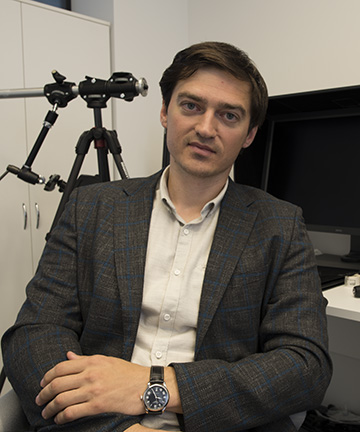
Dmitry Dylov
Dmitry Dylov is an assistant professor and head of the Computational Life Sciences program at the Center for Data-Intensive Science and Engineering (CDISE) at SkolTech—a Russian school established in collaboration with Massachusetts Institute of Technology (MIT), USA. Prior to joining SkolTech, Dmitry was a lead scientist at GE Global Research Center (Niskayuna, N.Y., USA), where he led various biomedical projects ranging from bioimaging and computational optics to big data and medical-image analytics.
Recently you started a new position at SkolTech CDISE in the AI field. What are you working on?
CDISE has the ambitious mission to serve as the foundation block for the conventional disciplines in academia, as almost all these disciplines are overflowing with data today and require “intelligent” analytics. I think this infrastructure portrays a general global trend in the ways institutions foster new talent today: artificial intelligence (AI) demands a core integration with any modern industrial, educational or research program.
Our discipline is not an exception. Intrinsically prone to generating big data, photonics is allowing for improved sensing using a boost from deep learning. Always aimed at resolving more content, imaging and machine vision are becoming relentlessly “smart.” Combined together, both optics and photonics become indispensable, enabling self-driving cars and intelligent robotics.
My research group, in parallel with academic research, offers expertise in AI that allows us to tackle a number of routine challenges encountered in the industry, mostly in the biomedical domain, by consulting or by direct execution on a contract.
How did you get involved in AI?
In my particular case, I first learned the major open-source frameworks for AI released by companies like Google and Facebook while working on a computational imaging project. Programs like TensorFlow and Caffe, which I recommend that everybody start with, make it easy to gain the necessary basic knowledge fast. I started reading about the subject and was able to quickly go beyond the original task and to automate some others that I hadn't even considered possible at that time—like unsupervised cell segmentation and detection!
Having a friend who guided me through the learning curve was very valuable at that time, and I highly recommend to anybody who is just about to venture into this field for the first time to engage an expert. Be prepared that they might be somewhat irritated, giving you the “yet another person” argument. Well … the hype is the hype.
As the use of deep learning became second nature to me, I realized that the methodology has a lot in common with the “layered” architectures encountered in optical or hydrodynamic modeling (think of simulating the intensity transfer or the Navier-Stokes). This realization has shed light on some new opportunities and naturally suggested the twofold focus of my research group, which is now working on computational imaging and AI itself.
Can you describe the challenges of setting up a lab in AI?
The main challenge of setting up a group with a “hype” expertise is the talent availability. It is immensely hard to compete with the major I.T. companies for the best talent; the I.T. giants offer very high compensation for data mining, image analytics and deep learning. Typically, faculty member positions can’t offer that much.
My advice is to interest your candidates with a “big unknown.” Many scientists, especially new graduates, will agree to sacrifice money for truly interesting research and an opportunity to discover something new in their area of interest.
Do you foresee that optical careers in robotics and AI will be a growing field?
Unquestionably! I am convinced that—whether we like it or not—the recent and the soon-to-be graduates in optics will be expected to know the basics of machine learning (and, ideally, to have an AI-based course listed in their CVs).
Even the most fundamental areas, ranging from high-energy lasers to quantum photonics, accept AI for their needs today. It is really hard to visualize the areas of optics and photonics that have not, or will not, benefit from AI in one way or another. If something is not published yet, it will soon be!
What are the skillsets that you look for when hiring someone in this field and what advice do you have for finding an optical career in robotics/AI?
First, it is very important to never stop improving your mathematical skillset—matrices, convolutions and probabilities are of particular relevance. Yes, tools make it easy to get a result without the math degree, but understanding the borders of AI applicability and capacity is anything but easy and is paramount to any application. When you need a little motivation to go back to the math textbooks, think about robots that will operate on humans in the future using your computer vision algorithm—are you absolutely sure that you needed that extra hidden layer?
Also, a paper in the field of AI can become a classic reference within months. Reading papers and looking at the codes of others on platforms like GitHub is more important than actual traditional education in computer science. The field is changing faster than any educational program could keep up with, and is the reason why we immerse our students into industrial collaborations immediately upon acceptance.
Finally, as you are joining the AI club, try to fight the hype—externally and, more importantly, in your mindset. Ironically, this often means controlling the use of phrases like “artificial intelligence” and “big data.” As with many disciplines that undergo exponential growth, Chekhov's advice applies: “Brevity is the sister of talent.” Be concise and specific with your proposals, ideas and reports!
